Sculptural light installations glow along Austin’s Waller Creek during 5th annual Creek Show
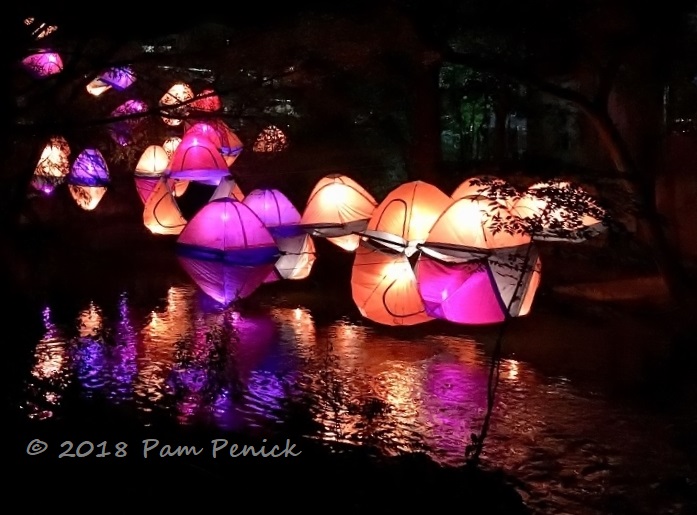
Last Saturday, on the final day of Creek Show 2018, hundreds of tents floated sinuously above downtown Austin’s Waller Creek, glowing orange and purple like fairy lights. To reach the start of this temporary art exhibition sponsored by Waller Creek Conservancy, which is remaking the long-neglected creek into a civic-jewel string of public parks, we’d just walked one block up an unlit stretch of the creek, passing shadowy figures of homeless men and women living under bridges and tunnels, and dodging piles of what looked like human waste on the sidewalk. The irony of all these unattainable tents in Creek Show’s opening light installation was not lost on us, nor was it meant to be.
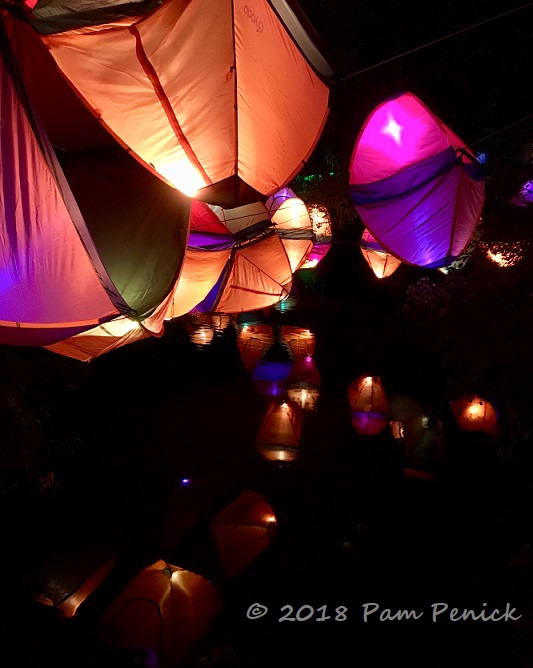
The piece is called Tentsion:
“Inspired by the tensions surrounding this particular location in Downtown Austin, this art installation manifests that tension into a battle between light and dark in an ever-evolving piece intended to spark dialogue and live on as something meaningful. To achieve this, the piece will be made out of camping tents bound together to create the forms which will then be deconstructed and donated to a local organization that serves those in need.”
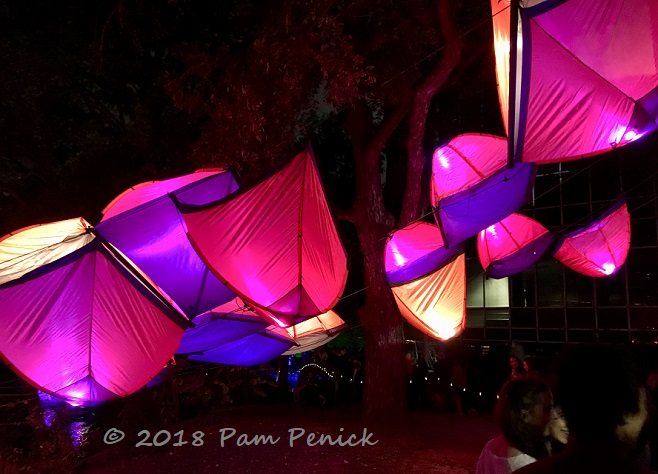
The display, undeniably beautiful, was also a painful acknowledgement of our failure as a society to meaningfully shelter our most vulnerable and difficult-to-help fellow citizens. I found it to be the most thought-provoking piece in this year’s exhibit.
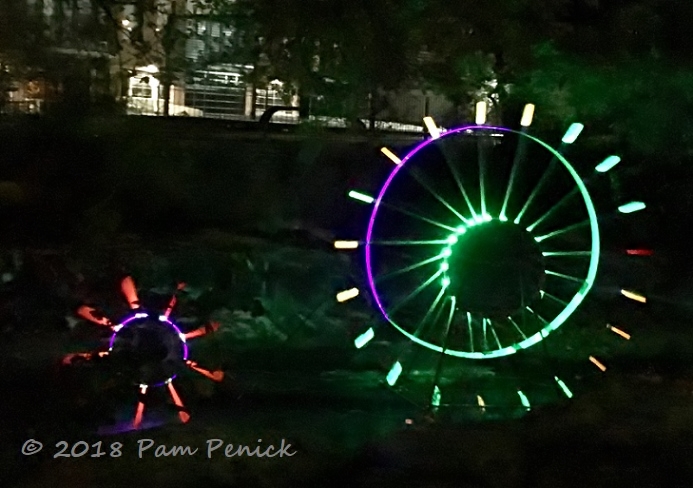
La Noria (Water Wheel) was easier to digest: two glowing wheels of light powered by the creek’s flow. The website explains:
“La Noria’s strength is drawn from the creek itself, and the system is entirely powered by the water’s movement. The resulting movement however appears greatly removed from the source; the spectacle of La Noria is far from natural, but is rather a mechanized dance, a tangle of spokes and lights and fluorescent colors. For the audience, there is tension in the recognition that this highly industrial sculpture is entirely self-sustained, reliant only on the power of the natural environment within which it sits.”
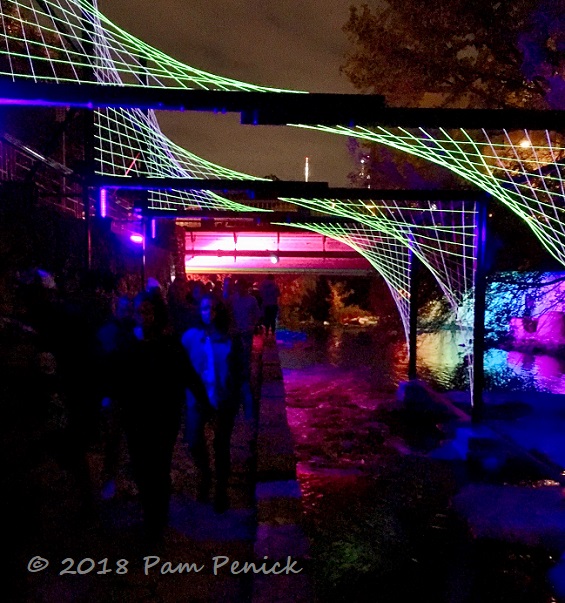
Next up was Parabolus, a webby tunnel of light referencing the bridges along Waller Creek:
“Parabolus draws inspiration from the architecture of the historic bridges of Waller Creek. Following the parabolic curve of the bridges constructed in 1930, Parabolus mirrors the architecture of the bridge and in turn the water mirrors light from the glowing bridge. Made of colored and luminous filaments, Parabolus draws your gaze to both water and sky, creating an immersive experience that emphasizes Waller Creek’s symbiotic urban and natural connection.”
I enjoyed the shadow-play and movement of Urban Scrim:
“Urban Scrim is a contemplative installation inspired by the simple forms and grand scale of West Texas land art. Weaving through the urban fabric of downtown, Waller Creek is often hidden from view. This piece acts as a serene beacon of light serving to attract viewers from the busy bustle of downtown with subtle projections of shadows from local pedestrians and reflections from the creek water. These projections encourage human interaction with Waller Creek by pairing the movement of the urban streetscape with the texture and nature of water flowing through the creek.”
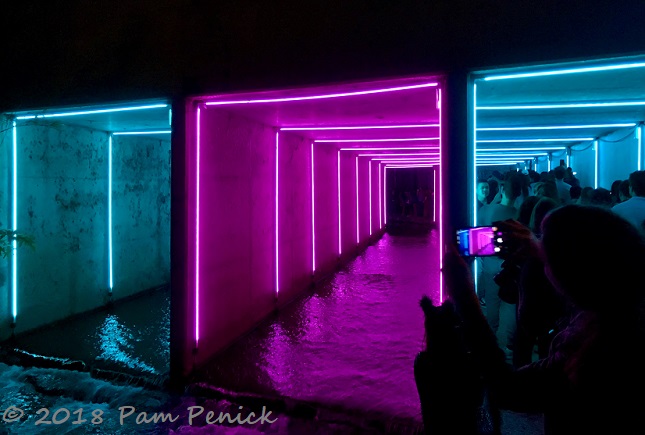
The crowd – and there were masses of people this year, compared to past years – jammed up at Ambedo Beta, a striking and selfie-beckoning neon-lit tunnel of light. Docents exhorted visitors to keep moving or step to the side for photos to keep the line moving, but everyone, including myself, wanted to stop and capture the dazzling display.
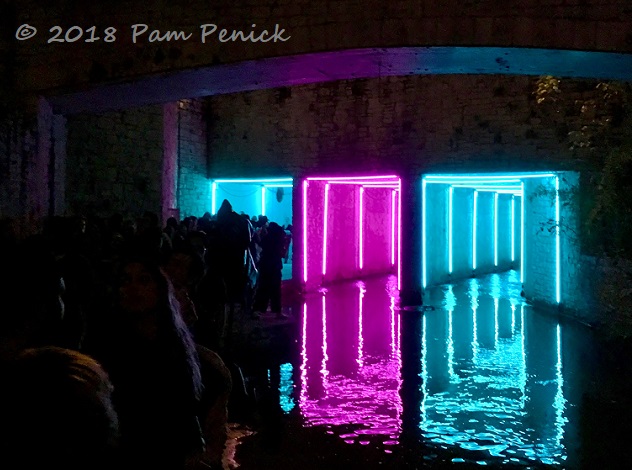
“Ambedo Beta is an interactive, immersive art installation. The concept revolves around two phone booths across the bridge from each other, facilitating a conversation between two strangers, where the communication is done through lighting frames throughout the three tunnels in various ways. By turning people’s voices into lights, Ambedo Beta reminds people that yes, your words do affect those around you. You will be able to gauge the response your words have as onlookers gaze at the light show those words create.”
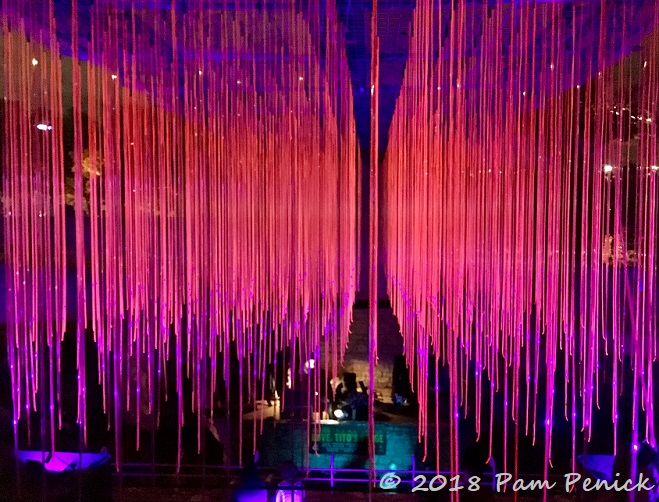
The light exhibit ended at Symphony Square, where a band was packing up its gear (ah, this is probably why the line to enter the show was wrapped around the block when we arrived earlier in the evening; we decamped to Easy Tiger for drinks and a cheese plate before returning just before the exhibit closed at 10 pm and got in quickly) and people were perched on the stone amphitheater seats beneath Light Lines, a monumental chandelier of glowing pink wires:
“Light Lines is inspired by Austin’s urban network of waterways and storm pipes, and portrays the compounding effect of storm water on Waller Creek’s watershed. Using electroluminescent wires suspended from a grid, Light Lines forms a structure of changing light and ambient sound, sending a message that the urban watershed is a system where ‘the whole is greater than the sum of its parts’. Light Lines visually bridges the creek while interactive touch points allow viewers to manipulate the light intensity as it moves across the structure and reflects upon the water.”
Symphony Square is also now the headquarters for Waller Creek Conservancy. We took a quick look inside to view a 3-D model and maps of the future parks and public spaces that the conservancy is fundraising to build. Creek Show is an event I enjoy attending every fall, and this year’s exhibit was better than ever, and well managed although perhaps the live music show could be held elsewhere so that the line to enter the exhibit doesn’t back up around an entire city block.
Also, I’d really like to see lighting installed in nearby sections of Waller Creek. We entered the creek about two blocks south of the exhibit – where in past years the show was held – and footing was treacherous on the narrow sidewalk of rugged stone, with no safety rail along the creek and no lighting beyond what could reach the area from the streets above. It felt unsafe, and dozens of homeless people were camping there in the dark and panhandling passersby.
Not to reflect on Creek Show’s event, but the fact is that aggressive panhandling is increasingly a problem in downtown Austin. I’ve been downtown two weekends in a row and experienced firsthand the in-your-face demands for money (and cursing if it’s not given) directed at locals and tourists alike. I don’t know what the solution is, but this is not good and seems to be getting worse.
Our city should be investing in civic spaces like Waller Creek, and I cheer on those efforts. But I can’t help wondering about the homeless, the mentally ill, and addicts living there now who will be shunted off to a new part of town, and how we must not turn away from finding solutions and ways to help that are more meaningful than handing out a few dollars here and there. It’s no way to live, not for them and not for those of us who are fortunate enough not to be in their shoes.
I welcome your comments; please scroll to the end of this post to leave one. If you’re reading this in a subscription email, click here to visit Digging and find the comment box at the end of each post.
_______________________
Digging Deeper: News and Upcoming Events
The Lady Bird Johnson Wildflower Center is hosting Luminations, a holiday light display in the gardens, December 6th through 9th between 6 and 9 pm. Tickets are $15 per person, $10 for members, and free for children up to 4 years old.
Join the mailing list for Garden Spark Talks! Inspired by the idea of house concerts, I’m hosting a series of garden talks by inspiring designers and authors out of my home. Talks are limited-attendance events and generally sell out within just a few days, so join the Garden Spark email list for early notifications. Simply click this link and ask to be added. I’ll be announcing the 2019 schedule soon to email subscribers.
All material © 2006-2018 by Pam Penick for Digging. Unauthorized reproduction prohibited.


I appreciated the light displays shown here much more than those installed at our own LA Arboretum, although I note that the audience and messages of each are also markedly different. I thinks it’s unfortunate that cities and states facing serious homeless problems aren’t actively collaborating in tackling the issue. When I worked in downtown LA two decades ago, homeless housing and panhandling were significant concerns even in broad daylight in the “nice” areas. (I worked in LA’s 72-story tower across the street from the Central Library and a stone’s throw from Disney Hall.) If anything, LA’s problem is even worse than it was then despite the increasing gentrification of the downtown area.
Collaboration would be smart. It’s going to be a very hard problem to solve.
And here. We have a few people who live around the library.
Some are trained as car guards, then find their way back to income and shelter.
The shelters are not enough.
We have social workers, but not everyone can ‘go home’. Or will.
There is no easy solution, for sure. And it’s a growing problem for cities like Austin.
Hello I saw and started to read another article of yours on low voltage outdoor lighting for landscapes so I subscribed but now I can’t find the whole article. I saw you had the same transformer as mine that I have to replace. It gets hung up trying to turn off. Question; all the new transformers have only one on/off setting where the one you show like mine can have multiple settings if you have the correct pins to turn it on and off. I called the manufacturer and they sold that division to Hampton Bay. Called Hampton Bay and they only make one that can turn on at dusk and off at sunrise using a photocell or it has one on/off Function.
We want to turn on at dusk off at 11pm then back on at 5AM and off at 6:30 AM
Any ideas on a manufacturer that meets the old transformer function. I have called several other manufacturers and no luck. I even visited several stores since the internet descriptions are not very good on some of the transformers.
I am a Master Gardener in Ohio.
David, the article about installing landscape lighting that you’re referring to is here: https://www.penick.net/digging/?p=42415. Our transformer died earlier this year, so we had to replace it and bought the one you mentioned, which automatically turns on at dusk and off at sunrise. We actually love this feature because we don’t have to think about changing the on/off times with the season anymore. I’m afraid I don’t have a recommendation for one that can be customized for certain times.